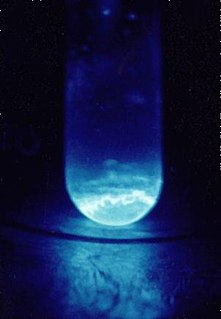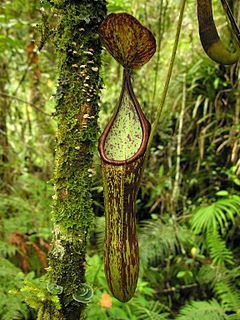
Berkelium is a transuranic radioactive chemical element with the symbol Bk and atomic number 97. It is a member of the actinide and transuranium element series. It is named after the city of Berkeley, California, the location of the Lawrence Berkeley National Laboratory where it was discovered in December 1949. Berkelium was the fifth transuranium element discovered after neptunium, plutonium, curium and americium.

Californium is a radioactive chemical element with the symbol Cf and atomic number 98. The element was first synthesized in 1950 at Lawrence Berkeley National Laboratory, by bombarding curium with alpha particles. It is an actinide element, the sixth transuranium element to be synthesized, and has the second-highest atomic mass of all elements that have been produced in amounts large enough to see with the naked eye. The element was named after the university and the U.S. state of California.

Einsteinium is a synthetic element with the symbol Es and atomic number 99. Einsteinium is a member of the actinide series and it is the seventh transuranium element. It was named in honor of Albert Einstein.

The Virgo Supercluster or the Local Supercluster is a mass concentration of galaxies containing the Virgo Cluster and Local Group, which itself contains the Milky Way and Andromeda galaxies, as well as others. At least 100 galaxy groups and clusters are located within its diameter of 33 megaparsecs. The Virgo SC is one of about 10 million superclusters in the observable universe and is in the Pisces–Cetus Supercluster Complex, a galaxy filament.
Nobelium (102No) is a synthetic element, and thus a standard atomic weight cannot be given. Like all synthetic elements, it has no stable isotopes. The first isotope to be synthesized was 254No in 1966. There are thirteen known radioisotopes, which are 249No to 260No and 262No, and five isomers, 249mNo, 250mNo, 251mNo, 253mNo, and 254mNo. The longest-lived isotope is 259No with a half-life of 58 minutes. The longest-lived isomer is 251mNo with a half-life of 1.7 seconds.

The phenylpropanoids are a diverse family of organic compounds that are synthesized by plants from the amino acids phenylalanine and tyrosine. Their name is derived from the six-carbon, aromatic phenyl group and the three-carbon propene tail of coumaric acid, which is the central intermediate in phenylpropanoid biosynthesis. From 4-coumaroyl-CoA emanates the biosynthesis of myriad natural products including lignols, flavonoids, isoflavonoids, coumarins, aurones, stilbenes, catechin, and phenylpropanoids. The coumaroyl component is produced from cinnamic acid.

Nepenthes copelandii is a species of pitcher plant native to the island of Mindanao in the Philippines. Originally known from Mount Apo near Davao City and Mount Pasian near Bislig, it has since been discovered on a number of peaks throughout Mindanao. It may also be present on the nearby island of Camiguin. The species has a wide altitudinal distribution of 1100–2400 m above sea level. Nepenthes copelandii has no known natural hybrids. No forms or varieties have been described.

Nepenthes mindanaoensis is a tropical pitcher plant native to the Philippine islands of Mindanao and Dinagat.

Nepenthes graciliflora is a tropical pitcher plant endemic to the Philippines. Long considered a synonym of N. alata, it was restored as a separate species in 2013 by Martin Cheek and Matthew Jebb. It has been recorded from the islands of Bohol, Leyte, Luzon, Mindanao, Mindoro, Panay, Samar, and Sibuyan, and following the redelimitation of N. alata is the most widespread Nepenthes species of the Philippines. It is known from mossy, submontane forest, generally at 800–1,280 metres (3,000–4,000 ft) altitude, though the type specimen from Sibuyan was collected at only 300 m (1,000 ft).

TRIMU-5 is a selective agonist of the μ2-opioid receptor and antagonist of the μ1-opioid receptor. It produces analgesia in animals that differs from that of conventional μ-opioid receptor agonists but that can still be blocked by μ-opioid receptor antagonists. TRIMU-5 can also block the analgesic effects of μ-opioid receptor agonists like morphine. In addition to analgesia, TRIMU-5 inhibits gastrointestinal transit, a known effect of μ2-opioid receptor activation.

POU domain, class 3, transcription factor 1 is a protein that in humans is encoded by the POU3F1 gene.

Nefopam, sold under the brand name Acupan among others, is a centrally acting, non-opioid painkilling medication, that is primarily used to treat moderate to severe pain.
(470308) 2007 JH43, provisional designation 2007 JH43, is a trans-Neptunian object in the outer regions of the Solar System, approximately 500 kilometers in diameter. It was discovered on 10 May 2007, by the U.S. Palomar Observatory in California. The team of unaccredited astronomers at Palomar consisted of Megan E. Schwamb, Michael E. Brown and David L. Rabinowitz

Lipik Crater is a crater in the Hellas quadrangle of Mars, located at 38.42° S and 248.43° W. It is 56 km in diameter and was named after Lipik, a town in Croatia. Close-up pictures of the crater show glacial features. The crater is not very deep, so much ice and dust may have accumulated over the years. If one measures the diameter of a crater, the original depth can be estimated with various ratios. Because of this relationship, researchers have found that many Martian craters contain a great deal of material; much of it is believed to be ice deposited when the climate was different.

A-86929 is a synthetic compound that acts as a selective dopamine receptor D1 agonist. It was developed as a possible treatment for Parkinson's disease, as well as for other applications such as treatment of cocaine addiction, but while it had reasonable efficacy in humans it also caused dyskinesias and has not been continued. It has mainly been used as its diacetate ester prodrug adrogolide (ABT-431), which has better bioavailability.

Berkelium forms a number of chemical compounds, where it normally exists in an oxidation state of +3 or +4, and behaves similarly to its lanthanide analogue, terbium. Like all actinides, berkelium easily dissolves in various aqueous inorganic acids, liberating gaseous hydrogen and converting into the trivalent oxidation state. This trivalent state is the most stable, especially in aqueous solutions, but tetravalent berkelium compounds are also known. The existence of divalent berkelium salts is uncertain and has only been reported in mixed lanthanum chloride-strontium chloride melts. Aqueous solutions of Bk3+ ions are green in most acids. The color of the Bk4+ ions is yellow in hydrochloric acid and orange-yellow in sulfuric acid. Berkelium does not react rapidly with oxygen at room temperature, possibly due to the formation of a protective oxide surface layer; however, it reacts with molten metals, hydrogen, halogens, chalcogens and pnictogens to form various binary compounds. Berkelium can also form several organometallic compounds.

Canertinib (CI-1033) is an experimental drug candidate for the treatment of cancer. It is an irreversible tyrosine-kinase inhibitor with activity against EGFR (IC50 0.8 nM), HER-2 (IC50 19 nM) and ErbB-4 (IC50 7 nM). By 2015, Pfizer had discontinued development of the drug.

Syringin is a natural chemical compound first isolated from the bark of lilac by Meillet in 1841. It has since been found to be distributed widely throughout many types of plants. It is also called eleutheroside B, and is found in Eleutherococcus senticosus. It is also found in dandelion coffee. Syringin may potentially have antidiabetic effects.
Nepenthes negros is a tropical pitcher plant native to the Philippines, specifically the islands of Biliran and Negros.

NGC 214 is a spiral galaxy in the northern constellation of Andromeda, located at a distance of 194 megalight-years from the Milky Way. It was discovered on September 10, 1784 by William Herschel. The shape of this galaxy is given by its morphological classification of SABbc, which indicates a weak bar-like structure (SAB) at the core and moderate to loosely-wound spiral arms (bc).

















